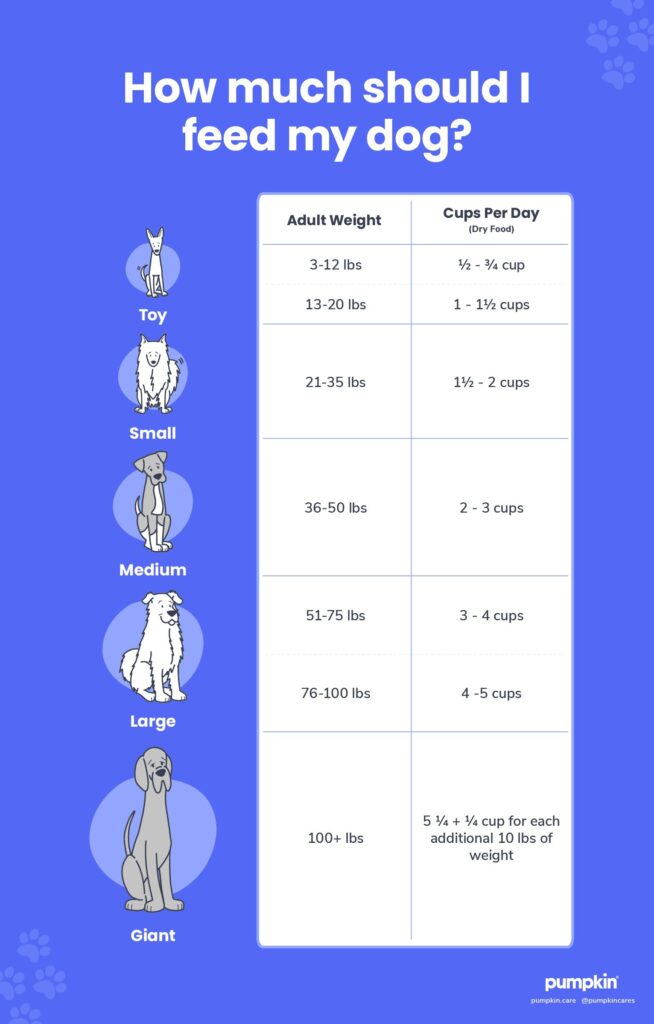Key Points
- Feeding your dog the right amount of food can help fuel energy levels and promote their overall health.
- How much food your dog needs will depend on factors such as their size, breed, lifestyle, and of course, the type of food and its caloric content.
- Read on for our easy-to-follow adult dog feeding chart!
Feeding your dog the right amount is key to their health and well-being. Exactly how much food your dog needs will depend on their breed, whether they are spayed or neutered or not, body weight, age, and even their lifestyle – for example, if your dog is a large breed doing daily agility training, they may require a bit more kibble than a small breed dog who spends most of their day napping!
That said, every dog has unique dietary needs, so be sure to consult with your veterinarian for the best advice. But if you’re looking for somewhere to start, read on for our feeding chart, as well as some meal time do’s and don’ts.
Feeding chart for adult dogs based on size and weight
From preventing obesity and the health problems that come with it, to fueling energy levels, there are endless benefits that come with good nutrition. But what does this look like for your dog?
Dog feeding amounts will vary by type of food, caloric content, and whether or not your dog is a healthy weight. You should always check the feeding chart on the back of your dog’s food packaging, but from a high level here is the right amount of dry dog food to give your adult dog each day:

Your dog’s age also plays a role in how much food they should eat. If you’re wondering how much to feed a puppy, for example, that’s a different story! Growing puppies need more food to aid in their development – usually, 2-3 times more food than the recommended amount for adult dogs. If you have a senior dog, on the other hand, they often need to cut back on their caloric intake to help maintain a healthy weight as they age. Not only is their metabolism slowing down, but so are their energy levels.
Feed your dog a high-quality dog food
In addition to feeding your dog the right portion size, it’s important to feed them high-quality dog food or puppy food, so that they receive the proper nutritional requirements.
So before you pick a random kibble out of a hat, do some research on the ingredients on the food label. What your dog eats really does affect their health, quality of life, and energy level. Some dog foods (and treats!) have more calories and fattier ingredients than others, which makes overfeeding your pup easy. This can lead to numerous health problems such as obesity, heart disease, hip and joint issues, and dental problems, to name a few.
What human food can I give my dog as a treat?
While those puppy eyes may pull at your heartstrings, feeding your dog scraps from the table every night is a no-no. Most human foods are too high in fat, sugar, salt, butter, and oils for our pups’ stomachs to tolerate. But every once in a while, we can sneak our dog some human food treats, so long as they’re clean and safe! If the question, “Can my dog eat that?” ever crosses your mind – always be sure to do your research.
Tip: Remember that dog treats should only make up 10% of your pooch’s overall diet. The other 90% should come from their daily meals.
Safe human foods for dogs to eat as treats
This is by no means an exhaustive list, but here are a couple of human foods that are safe for your dog to eat. Like everything, these should be enjoyed in moderation! And if your dog shows signs of a food allergy, stop giving them these foods and consult your vet.
When feeding any of the safe foods listed below to your dog, make sure to remove any skin, stems, leaves, rinds, peels, and cores. You also want to double-check that they’re not mixed with things like sugar, salt, and butter. Most importantly, make sure there is no xylitol in anything you give to your dog. Even peanut butter can sometimes contain xylitol, which is extremely toxic to dogs. Here are some generally safe human snacks to feed your dog:
- Carrots
- Celery
- Green beans
- Watermelon
- Strawberries
- Blueberries
- Bananas
- Cantaloupe
- Peanut butter
- Pumpkin
Non-safe human foods for dogs to eat
Never let your dog eat any of the following food or ingredients because they are extremely toxic. If your dog has eaten any of these, we recommend taking them to the veterinarian immediately. There are more beyond this list, but here are the big ones:
- Grapes
- Raisins
- Onions
- Garlic
- Xylitol
- Nutmeg
What number of meals should a dog eat in a day?
You may think that it’s easier to feed your dog one big meal and let them graze all day (especially if you have a picky eater), but this isn’t the healthiest option. Not only can it lead to overeating or undereating, but it can also be confusing for your pooch. Dogs thrive on consistency and routine, and their meals are a big part of that.
That said, feeding your dog twice a day, based on the above feeding chart, will help create a regular feeding schedule for your pup. This will help keep their bellies full, and energy up, and will train them to eat the food that is provided to them. This is especially important for puppies who are still learning their feeding schedule.
Should dogs take supplements?
Supplements are a great way to help improve your dog’s overall health. Think of them as a daily vitamin for your dog!
They can even be necessary if your dog has certain health problems such as a skin problem or dietary needs such as food to support their urinary health. You can always consult your veterinarian about which supplements would be best for your dog.
How much exercise does a dog need?
In addition to feeding your dog the appropriate amount of food, it’s extremely important to keep your pup active with plenty of exercise every day.
Similar to how much food your dog needs, how much exercise your dog needs will depend on your dog’s weight, breed, age, and lifestyle. At the very least, every healthy adult dog should be getting 30-45 minutes of exercise per day, but 60 minutes is ideal.
Not only will regular exercise help keep your dog happy and healthy, but it will also help minimize the “zoomies” or restless behavior we’ve all experienced at one point or another, as well as other unwanted behaviors associated with boredom, such as anxiety or aggression. Do yourself and your pup a favor, and get to stepping!
Tip: Remember that most dogs were bred to move! Many breeds’ ancestors were hunters, workers, and herders. All dogs require a minimum activity level to help manage their weight and stimulate them mentally – doing research on your dog’s breed can help determine this.
How much you feed your dog is only one part of the equation in ensuring they lead a happy, healthy life – but it’s a big one. When in doubt, consult your veterinarian! They will be able to work with you on making the best feeding plan for your pup’s unique nutritional needs.
As a loving pet parent, we know you only want the best care possible for your canine companion. That’s why Pumpkin Dog Insurance plans are here to help you worry less about cost and more about care — no matter what curveballs life throws at you.




